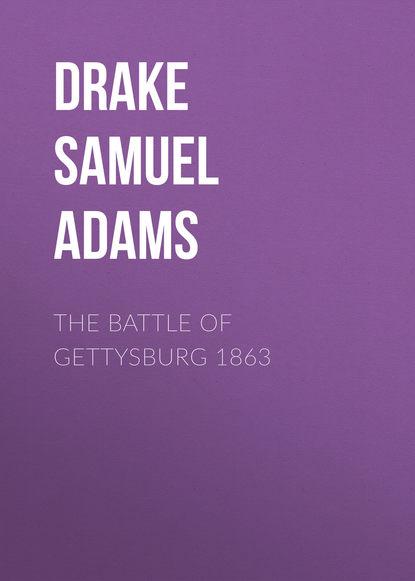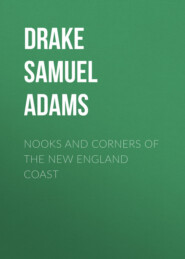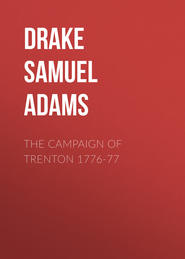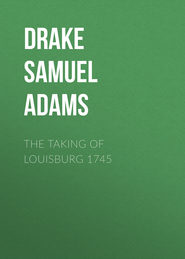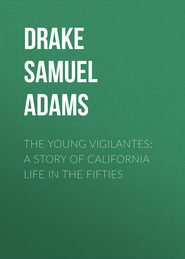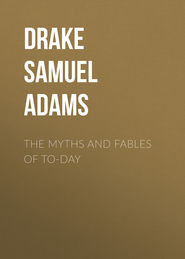По всем вопросам обращайтесь на: info@litportal.ru
(©) 2003-2024.
✖
The Battle of Gettysburg 1863
Настройки чтения
Размер шрифта
Высота строк
Поля
The Battle of Gettysburg 1863
Samuel Drake
Samuel Adams Drake
The Battle of Gettysburg 1863
I
Gettysburg[1 - Gettysburg is the county seat of Adams County; is one hundred and fourteen miles west of Philadelphia. Pennsylvania College is located here.]
The Town.
Stripped of the glamour which has made its every stick and stone an object of eager curiosity or pious veneration, Gettysburg becomes a very plain, matter-of-fact Pennsylvania town, of no particular antiquity, with a very decided Dutch flavor in the names and on the tongues of its citizens, where no great man has ever flourished, or anything had happened to cause its own name to be noised abroad, until one day in the eventful year 1863 – the battle year – fame was suddenly thrust upon it, as one might say, not for a day, but for all time. The dead who sleep in the National Cemetery[2 - The National Cemetery was dedicated by Abraham Lincoln, Nov. 19, 1863; it is a place of great and growing interest and beauty. The National Monument standing on this ground, where sleeps an army, was dedicated by General Meade in 1869. The monument itself was designed by J. G. Batterson, of Hartford, Conn., the statuary by Randolph Rogers. In 1872 the cemetery was transferred to the national government. A large part of the adjoining ridge is in charge of the Gettysburg Battlefield Memorial Association, a corporation formed under the laws of Pennsylvania for the preservation of the field and its landmarks. No other battle-ground was ever so distinctly marked or so easily traced as this.] here, or who lie in unknown graves about the fields and woods, and counting many times more than the living, help us to understand how much greater was the battle of Gettysburg than the town which has given it its name.
Gettysburg is the market town – or borough, accurately speaking – of an exclusively farming population, planted in one of the most productive sections of the Keystone State. It is the seat of justice of the county. It has a seminary and college of the German Lutheran Church, which give a certain tone and cast to its social life. In short, Gettysburg seems in all things so entirely devoted to the pursuits of peace, there is so little that is suggestive of war and bloodshed, even if time had not mostly effaced all traces of that gigantic struggle,[3 - Shells remain sticking in the walls of some buildings yet. A memorial stone at the steps in front of the Lutheran church, on Chambersburg street, indicates the spot where Chaplain Howell, of the 90th Pennsylvania Volunteers, was shot dead while entering the church, then being used as a hospital.] that, coming as we do with one absorbing idea in mind, we find it hard to reconcile the facts of history with the facts as we find them.
The Landscape.
There is another side to Gettysburg – a picturesque, a captivating side. One looks around upon the landscape with simple admiration. One's highest praise comes from the feeling of quiet satisfaction with which the harmony of nature reveals the harmony of God. You are among the subsiding swells that the South Mountain has sent rippling off to the east. So completely is the village hid away among these green swells that neither spire nor steeple is seen until, upon turning one of the numerous low ridges by which the face of the country is so cut up, you enter a valley, not deep, but well defined by two opposite ranges of heights, and Gettysburg lies gleaming in the declining sun before you – a picture to be long remembered.
Its situation is charming. Here and there a bald ridge or wooded hill, the name of which you do not yet know, is pushed or bristles up above the undulating prairie-land, but there is not one really harsh feature in the landscape. In full view off to the northwest, but softened by the gauzy haze of a midsummer's afternoon, the towering bulk of the South Mountain, vanguard of the serried chain behind it, looms imposingly up between Gettysburg and the Cumberland Valley, still beyond, in the west, as landmark for all the country round, as well as for the great battlefield now spreading out its long leagues before you; a monument more aged than the Pyramids, which Napoleon, a supremely imaginative and magnetic man himself, sought to invest with a human quality in the minds of his veterans, when he said to them, "Soldiers! from the summits of yonder Pyramids forty ages behold you." In short, the whole scene is one of such quiet pastoral beauty, the village itself with its circlet of fields and farms so free from every hint of strife and carnage, that again and again we ask ourselves if it can be true that one of the greatest conflicts of modern times was lost and won here.
Yet this, and this alone, is what has caused Gettysburg, the obscure country village, to be inscribed on the same scroll with Blenheim, and Waterloo, and Saratoga, as a decisive factor in the history of the nations. Great deeds have lifted it to monumental proportions. As Abraham Lincoln so beautifully said when dedicating the National Cemetery here, "The brave men, living and dead, who struggled here have consecrated it far above our power to add or detract. The world will little note, nor long remember, what we say here, but it can never forget what they did here."
Those noble words ought to be the guiding inspiration of every one who intends adding his own feeble impressions of this great battle to what has been said before.
Strategic Importance.
Playing at Blind-Man's-Buff.
The strategic importance that Gettysburg suddenly assumed during Lee's invasion of Pennsylvania, in July, 1863, first demands a little of our attention. Yet it seems certain that neither Meade nor Lee had thought of it as a possible battle-ground until accident thrust it upon them. At his first setting out on this campaign Lee had not been able to say, with the map before him, "I will fight a battle either in this or that place," because he had marched not toward, but away from, his adversary, and, so far as can be known, without choosing beforehand a position where Meade would have to come and attack him. For his part, so long as Meade was only following Lee about, the Union general cannot be said to have had much voice in the matter. It was Lee who was really directing Meade's march. True enough, Meade did select a battlefield, but not here, at Gettysburg; nor do we know, nor would it be useful to inquire, whether Lee could have been induced to fight just where Meade wanted him to. As Lee fought at Gettysburg only because he was struck, it is probably beyond any man's power to say that if this had not happened, as it did, Lee would have marched on toward Baltimore, knowing that Meade's army lay intrenched in his path. There is a homely maxim running to the effect that you can lead a horse to water, but cannot make him drink. The two generals, therefore, merely launched their columns out hit or miss, like men playing at blind-man's-buff.
Gettysburg lies at the apex of a triangle of which Harrisburg and Baltimore form the base angles, at north and south – Harrisburg being only thirty-six and Baltimore about fifty miles distant. York and Carlisle also lie either on or so near this triangle as to come within its scope as a basis for military operations. Placed at Gettysburg, an army threatened all of these points.
Diagram showing strategic value of Gettysburg. H., Harrisburg; G., Gettysburg; P., Philadelphia; Y., York; B., Baltimore; W., Washington.
Topographical Features.
Baltimore and Taneytown Roads.
Cemetery Hill.
From a military point of view there are but two features about Gettysburg on which the eye would long rest. These are the two ridges, with a broad valley between, heaved up at east and west and running off south of the town. They stand about a mile apart, though the distance is sometimes less than that. As it nears Gettysburg the easternmost ridge glides down, by a gentle slope, into what may be called a plain, in comparison with the upheavals around it, although it is by no means a dead level. Yet it is open because the ridges themselves have stopped short here, forming headlands, so to speak, above the lower swells. On coming down off this ridge the descent is seen to be quite easy – in fact, two roads ascend it by so gradual a rise that the notion of its being either high or steep is quite lost, and you are ready to discard off-hand any preconceived notion about its being a natural stronghold. It is mostly on this slope that Gettysburg is built, its houses extending well up toward the brow, and its cemetery occupying the brow itself. Hence, although the centre of Gettysburg may be three-fourths of a mile from the cemetery gate, the town site is in fact but a lower swell of the historic ridge which has since taken the name of its graveyard – Cemetery Ridge.
Seminary Ridge.
Across this valley, again, the western ridge, which looks highest from the town, has what Cemetery Hill has not, namely, a thin fringe of trees skirting its entire crest, thus effectually masking the view in that direction; and it is further distinguished by the cupola of the Lutheran Seminary,[4 - The Lutheran Seminary was used both as a hospital and observatory by the Confederates. Lee's headquarters were in a little stone house quite near the seminary buildings, which are not more than half a mile from the centre of Gettysburg.] seen rising above trees at a point opposite the town, and giving its name to this ridge – Seminary Ridge. Both ranges of heights are quite level at the top, and easily traversed; so also the slopes of both are everywhere easy of ascent, the ground between undulating, but nowhere, except far down the valley, badly cut up by ravines or watercourses. Indeed, better ground for a fair stand-up fight it would be hard to find; for all between the two ridges is so clear and open that neither army could stir out toward its opponent without being detected at once – the extreme southern part of the valley excepted. In this respect I take the liberty of observing that the actual state of things proved very different from that conveyed in some of the published accounts, wherein Cemetery Ridge is represented as a sort of Gibraltar.
A very brief survey, however, suggests that an army could be perfectly hid behind the trees of Seminary Ridge, as well as better sheltered from artillery fire, while one stretched out along the bare and treeless summit of Cemetery Ridge would be without such screen or protection.
The description must be a little farther pursued, if the battle is to be at all intelligently followed.
Enough for the two main ridges enclosing Gettysburg and its valley. We come now to that most striking feature of the landscape, notably on the side of Cemetery Ridge, but more or less characteristic of both sides of the valley. This is the group of hills standing off from Cemetery Ridge at either end, just as if, at some remote time, this ridge had formed a continuous chain, the summits of which had been cleanly shaved off at the centre, leaving these isolated clusters to show where the wasting forces had passed. From different points of view we may see one or both of them rising above the ridge like giant watch-towers set at the extremities of some high embattled wall.
Culp's Hill.
Rock Creek.
Let us first take the northernmost cluster, formed of Wolf's, McAllister's, and Culp's hills. It is seen to be thrown back behind Cemetery Hill, to which Culp's Hill alone is slenderly attached by a low ridge, so making an elbow with it, or, in the military phrase, a refused line. Between Culp's Hill and Wolf's Hill flows Rock Creek, the shallow stream so often mentioned in connection with the battle, its course lying through a shaggy ravine.[5 - In 1863 all these hills were much more densely wooded than now, so forming an impenetrable screen to their defenders.] The ravine and stream of Rock Creek threw Wolf's Hill somewhat out of the true line of defence, but the merest novice in military art sees at a glance why the possession of Culp's Hill was all-essential to the security of Cemetery Hill, since there is little use in shutting the front door if the back door is to be left standing open.
The Round Tops.
The Devil's Den.
The same is just as true of the southernmost group, composed of Little and Great Round Tops, two exceedingly picturesque summits, standing up above the generally monotonous contours about them in strong relief. They also were wooded from base to summit, and they show, even more distinctly than the first group, where the crushing out or denuding forces have been at work, in shelves or crevices of broken ledge at the highest points, in ugly bowlders cropping out on the slopes, in miry gullies crawling at their feet, but most of all in the deformed heap of ripped-up ledges, topped with coppices and scattered trees, thrust out from Little Round Top and known as the Devil's Den.[6 - The bowlder-strewn strip of ground lying between Devil's Den and Little Round Top is the most impressive part of the field, I think.]
When it is added that the way is open between the two Round Tops to the rear of Cemetery Ridge, the importance of holding them firmly becomes self-evident; and inasmuch as the greatest natural strength of this ridge lay at its extremities, or flanks, so its weakness would result from a neglect to occupy those flanks.
The Swale.
This line was assailable at one other point. As it approaches Little Round Top the ridge sinks away to the general level around it, or so as to break its continuity, thus leaving a gap more or less inviting the approach of an enemy. The whole extent of this crooked line, at which we have just glanced, is about two and a half miles.
Emmettsburg Road.
Down below, in the valley, there is another swell of ground, hardly worth dignifying by the name of ridge, yet assuming a certain importance, nevertheless, first because it starts from the town close under Cemetery Hill, thence crossing the valley diagonally till it becomes merged in Seminary Ridge, at a point nearly opposite to the Round Tops, and next because the Emmettsburg road runs on it. In brief, its relation to the battle was this: it ran from the Union right into the Confederate right, so traversing the entire front of both armies. It had an important part to play in the second day's battle, as we shall soon see, for, though occupying three days, Gettysburg was but a series of combats in which neither army employed its whole force at any one time.
II
THE MARCH INTO PENNSYLVANIA
Lee in Maryland.
It is in no way essential to relate in detail how Lee's army, slipping away from ours on the Rappahannock,[7 - He withdrew two corps, by his left, to Culpepper, leaving one in the trenches of Fredericksburg. Had this corps been crushed while thus isolated, as it ought, Lee's invasion must have ended then and there.] and after brushing out of its path our troops posted in the Shenandoah Valley, had been crossing the Potomac into Maryland since the 21st of June, by way of the Cumberland Valley, without firing a shot.[8 - A glance at the map shows how the northerly bend of the Potomac facilitated an invasion by this route. The outposts at Harper's Ferry and Winchester having been forced, there was nothing to stop the enemy's advance.]
His Bold Strategy.
A very unusual thing in war it is to see an army which has just been acting strictly on the defensive suddenly elude its adversary for the purpose of carrying the war into that enemy's country! It marks a new epoch in the history of that war, and it supposes wholly altered conditions. In this particular instance Lee's moves were so bold as almost to savor of contempt.
It is enough to know that Lee was now in Pennsylvania, at the head of seventy thousand men, before our army reached the Potomac in pursuit of him, if following at a respectful distance be called a pursuit.
State of his Army.
At no period of the war, their own officers said, had the Confederates been so well equipped, so well clothed, so eager for a fight, or so confident of success; and we may add our own conclusions, that never before had this army taken the field so strong in numbers, or with such a powerful artillery.[9 - The Confederate army comprised three infantry corps, and one of cavalry. Each corps had three divisions, each division averaged a little over four brigades, of which there were thirty-seven present at Gettysburg. The British Colonel Freemantle, who accompanied Lee's army, puts the strength of these brigades at two thousand eight hundred men each. The relative strength of the army corps was more nearly equal than in those of the Union army. The Confederates brought with them two hundred and seventy pieces of artillery.]
Superiority as Marksmen.
The infantry were armed with Enfield rifles, fresh from British workshops, and it is probable that no equal number of men ever knew how to use them better. Indeed, we consider it indisputable that the Confederates greatly excelled the Union soldiers as marksmen. Most of them were accustomed to the use of firearms from boyhood; in some sections they were noted for their skill with the rifle. The Confederates, therefore, were nearly always good shots before they went into the army, while the Union soldiers mostly had to acquire what skill they could after going into the ranks. In the South the habit of carrying arms was almost universal: in the North it was not only unusual, but unpopular as well as unlawful.
Superiority in Cavalry.
Samuel Drake
Samuel Adams Drake
The Battle of Gettysburg 1863
I
Gettysburg[1 - Gettysburg is the county seat of Adams County; is one hundred and fourteen miles west of Philadelphia. Pennsylvania College is located here.]
The Town.
Stripped of the glamour which has made its every stick and stone an object of eager curiosity or pious veneration, Gettysburg becomes a very plain, matter-of-fact Pennsylvania town, of no particular antiquity, with a very decided Dutch flavor in the names and on the tongues of its citizens, where no great man has ever flourished, or anything had happened to cause its own name to be noised abroad, until one day in the eventful year 1863 – the battle year – fame was suddenly thrust upon it, as one might say, not for a day, but for all time. The dead who sleep in the National Cemetery[2 - The National Cemetery was dedicated by Abraham Lincoln, Nov. 19, 1863; it is a place of great and growing interest and beauty. The National Monument standing on this ground, where sleeps an army, was dedicated by General Meade in 1869. The monument itself was designed by J. G. Batterson, of Hartford, Conn., the statuary by Randolph Rogers. In 1872 the cemetery was transferred to the national government. A large part of the adjoining ridge is in charge of the Gettysburg Battlefield Memorial Association, a corporation formed under the laws of Pennsylvania for the preservation of the field and its landmarks. No other battle-ground was ever so distinctly marked or so easily traced as this.] here, or who lie in unknown graves about the fields and woods, and counting many times more than the living, help us to understand how much greater was the battle of Gettysburg than the town which has given it its name.
Gettysburg is the market town – or borough, accurately speaking – of an exclusively farming population, planted in one of the most productive sections of the Keystone State. It is the seat of justice of the county. It has a seminary and college of the German Lutheran Church, which give a certain tone and cast to its social life. In short, Gettysburg seems in all things so entirely devoted to the pursuits of peace, there is so little that is suggestive of war and bloodshed, even if time had not mostly effaced all traces of that gigantic struggle,[3 - Shells remain sticking in the walls of some buildings yet. A memorial stone at the steps in front of the Lutheran church, on Chambersburg street, indicates the spot where Chaplain Howell, of the 90th Pennsylvania Volunteers, was shot dead while entering the church, then being used as a hospital.] that, coming as we do with one absorbing idea in mind, we find it hard to reconcile the facts of history with the facts as we find them.
The Landscape.
There is another side to Gettysburg – a picturesque, a captivating side. One looks around upon the landscape with simple admiration. One's highest praise comes from the feeling of quiet satisfaction with which the harmony of nature reveals the harmony of God. You are among the subsiding swells that the South Mountain has sent rippling off to the east. So completely is the village hid away among these green swells that neither spire nor steeple is seen until, upon turning one of the numerous low ridges by which the face of the country is so cut up, you enter a valley, not deep, but well defined by two opposite ranges of heights, and Gettysburg lies gleaming in the declining sun before you – a picture to be long remembered.
Its situation is charming. Here and there a bald ridge or wooded hill, the name of which you do not yet know, is pushed or bristles up above the undulating prairie-land, but there is not one really harsh feature in the landscape. In full view off to the northwest, but softened by the gauzy haze of a midsummer's afternoon, the towering bulk of the South Mountain, vanguard of the serried chain behind it, looms imposingly up between Gettysburg and the Cumberland Valley, still beyond, in the west, as landmark for all the country round, as well as for the great battlefield now spreading out its long leagues before you; a monument more aged than the Pyramids, which Napoleon, a supremely imaginative and magnetic man himself, sought to invest with a human quality in the minds of his veterans, when he said to them, "Soldiers! from the summits of yonder Pyramids forty ages behold you." In short, the whole scene is one of such quiet pastoral beauty, the village itself with its circlet of fields and farms so free from every hint of strife and carnage, that again and again we ask ourselves if it can be true that one of the greatest conflicts of modern times was lost and won here.
Yet this, and this alone, is what has caused Gettysburg, the obscure country village, to be inscribed on the same scroll with Blenheim, and Waterloo, and Saratoga, as a decisive factor in the history of the nations. Great deeds have lifted it to monumental proportions. As Abraham Lincoln so beautifully said when dedicating the National Cemetery here, "The brave men, living and dead, who struggled here have consecrated it far above our power to add or detract. The world will little note, nor long remember, what we say here, but it can never forget what they did here."
Those noble words ought to be the guiding inspiration of every one who intends adding his own feeble impressions of this great battle to what has been said before.
Strategic Importance.
Playing at Blind-Man's-Buff.
The strategic importance that Gettysburg suddenly assumed during Lee's invasion of Pennsylvania, in July, 1863, first demands a little of our attention. Yet it seems certain that neither Meade nor Lee had thought of it as a possible battle-ground until accident thrust it upon them. At his first setting out on this campaign Lee had not been able to say, with the map before him, "I will fight a battle either in this or that place," because he had marched not toward, but away from, his adversary, and, so far as can be known, without choosing beforehand a position where Meade would have to come and attack him. For his part, so long as Meade was only following Lee about, the Union general cannot be said to have had much voice in the matter. It was Lee who was really directing Meade's march. True enough, Meade did select a battlefield, but not here, at Gettysburg; nor do we know, nor would it be useful to inquire, whether Lee could have been induced to fight just where Meade wanted him to. As Lee fought at Gettysburg only because he was struck, it is probably beyond any man's power to say that if this had not happened, as it did, Lee would have marched on toward Baltimore, knowing that Meade's army lay intrenched in his path. There is a homely maxim running to the effect that you can lead a horse to water, but cannot make him drink. The two generals, therefore, merely launched their columns out hit or miss, like men playing at blind-man's-buff.
Gettysburg lies at the apex of a triangle of which Harrisburg and Baltimore form the base angles, at north and south – Harrisburg being only thirty-six and Baltimore about fifty miles distant. York and Carlisle also lie either on or so near this triangle as to come within its scope as a basis for military operations. Placed at Gettysburg, an army threatened all of these points.
Diagram showing strategic value of Gettysburg. H., Harrisburg; G., Gettysburg; P., Philadelphia; Y., York; B., Baltimore; W., Washington.
Topographical Features.
Baltimore and Taneytown Roads.
Cemetery Hill.
From a military point of view there are but two features about Gettysburg on which the eye would long rest. These are the two ridges, with a broad valley between, heaved up at east and west and running off south of the town. They stand about a mile apart, though the distance is sometimes less than that. As it nears Gettysburg the easternmost ridge glides down, by a gentle slope, into what may be called a plain, in comparison with the upheavals around it, although it is by no means a dead level. Yet it is open because the ridges themselves have stopped short here, forming headlands, so to speak, above the lower swells. On coming down off this ridge the descent is seen to be quite easy – in fact, two roads ascend it by so gradual a rise that the notion of its being either high or steep is quite lost, and you are ready to discard off-hand any preconceived notion about its being a natural stronghold. It is mostly on this slope that Gettysburg is built, its houses extending well up toward the brow, and its cemetery occupying the brow itself. Hence, although the centre of Gettysburg may be three-fourths of a mile from the cemetery gate, the town site is in fact but a lower swell of the historic ridge which has since taken the name of its graveyard – Cemetery Ridge.
Seminary Ridge.
Across this valley, again, the western ridge, which looks highest from the town, has what Cemetery Hill has not, namely, a thin fringe of trees skirting its entire crest, thus effectually masking the view in that direction; and it is further distinguished by the cupola of the Lutheran Seminary,[4 - The Lutheran Seminary was used both as a hospital and observatory by the Confederates. Lee's headquarters were in a little stone house quite near the seminary buildings, which are not more than half a mile from the centre of Gettysburg.] seen rising above trees at a point opposite the town, and giving its name to this ridge – Seminary Ridge. Both ranges of heights are quite level at the top, and easily traversed; so also the slopes of both are everywhere easy of ascent, the ground between undulating, but nowhere, except far down the valley, badly cut up by ravines or watercourses. Indeed, better ground for a fair stand-up fight it would be hard to find; for all between the two ridges is so clear and open that neither army could stir out toward its opponent without being detected at once – the extreme southern part of the valley excepted. In this respect I take the liberty of observing that the actual state of things proved very different from that conveyed in some of the published accounts, wherein Cemetery Ridge is represented as a sort of Gibraltar.
A very brief survey, however, suggests that an army could be perfectly hid behind the trees of Seminary Ridge, as well as better sheltered from artillery fire, while one stretched out along the bare and treeless summit of Cemetery Ridge would be without such screen or protection.
The description must be a little farther pursued, if the battle is to be at all intelligently followed.
Enough for the two main ridges enclosing Gettysburg and its valley. We come now to that most striking feature of the landscape, notably on the side of Cemetery Ridge, but more or less characteristic of both sides of the valley. This is the group of hills standing off from Cemetery Ridge at either end, just as if, at some remote time, this ridge had formed a continuous chain, the summits of which had been cleanly shaved off at the centre, leaving these isolated clusters to show where the wasting forces had passed. From different points of view we may see one or both of them rising above the ridge like giant watch-towers set at the extremities of some high embattled wall.
Culp's Hill.
Rock Creek.
Let us first take the northernmost cluster, formed of Wolf's, McAllister's, and Culp's hills. It is seen to be thrown back behind Cemetery Hill, to which Culp's Hill alone is slenderly attached by a low ridge, so making an elbow with it, or, in the military phrase, a refused line. Between Culp's Hill and Wolf's Hill flows Rock Creek, the shallow stream so often mentioned in connection with the battle, its course lying through a shaggy ravine.[5 - In 1863 all these hills were much more densely wooded than now, so forming an impenetrable screen to their defenders.] The ravine and stream of Rock Creek threw Wolf's Hill somewhat out of the true line of defence, but the merest novice in military art sees at a glance why the possession of Culp's Hill was all-essential to the security of Cemetery Hill, since there is little use in shutting the front door if the back door is to be left standing open.
The Round Tops.
The Devil's Den.
The same is just as true of the southernmost group, composed of Little and Great Round Tops, two exceedingly picturesque summits, standing up above the generally monotonous contours about them in strong relief. They also were wooded from base to summit, and they show, even more distinctly than the first group, where the crushing out or denuding forces have been at work, in shelves or crevices of broken ledge at the highest points, in ugly bowlders cropping out on the slopes, in miry gullies crawling at their feet, but most of all in the deformed heap of ripped-up ledges, topped with coppices and scattered trees, thrust out from Little Round Top and known as the Devil's Den.[6 - The bowlder-strewn strip of ground lying between Devil's Den and Little Round Top is the most impressive part of the field, I think.]
When it is added that the way is open between the two Round Tops to the rear of Cemetery Ridge, the importance of holding them firmly becomes self-evident; and inasmuch as the greatest natural strength of this ridge lay at its extremities, or flanks, so its weakness would result from a neglect to occupy those flanks.
The Swale.
This line was assailable at one other point. As it approaches Little Round Top the ridge sinks away to the general level around it, or so as to break its continuity, thus leaving a gap more or less inviting the approach of an enemy. The whole extent of this crooked line, at which we have just glanced, is about two and a half miles.
Emmettsburg Road.
Down below, in the valley, there is another swell of ground, hardly worth dignifying by the name of ridge, yet assuming a certain importance, nevertheless, first because it starts from the town close under Cemetery Hill, thence crossing the valley diagonally till it becomes merged in Seminary Ridge, at a point nearly opposite to the Round Tops, and next because the Emmettsburg road runs on it. In brief, its relation to the battle was this: it ran from the Union right into the Confederate right, so traversing the entire front of both armies. It had an important part to play in the second day's battle, as we shall soon see, for, though occupying three days, Gettysburg was but a series of combats in which neither army employed its whole force at any one time.
II
THE MARCH INTO PENNSYLVANIA
Lee in Maryland.
It is in no way essential to relate in detail how Lee's army, slipping away from ours on the Rappahannock,[7 - He withdrew two corps, by his left, to Culpepper, leaving one in the trenches of Fredericksburg. Had this corps been crushed while thus isolated, as it ought, Lee's invasion must have ended then and there.] and after brushing out of its path our troops posted in the Shenandoah Valley, had been crossing the Potomac into Maryland since the 21st of June, by way of the Cumberland Valley, without firing a shot.[8 - A glance at the map shows how the northerly bend of the Potomac facilitated an invasion by this route. The outposts at Harper's Ferry and Winchester having been forced, there was nothing to stop the enemy's advance.]
His Bold Strategy.
A very unusual thing in war it is to see an army which has just been acting strictly on the defensive suddenly elude its adversary for the purpose of carrying the war into that enemy's country! It marks a new epoch in the history of that war, and it supposes wholly altered conditions. In this particular instance Lee's moves were so bold as almost to savor of contempt.
It is enough to know that Lee was now in Pennsylvania, at the head of seventy thousand men, before our army reached the Potomac in pursuit of him, if following at a respectful distance be called a pursuit.
State of his Army.
At no period of the war, their own officers said, had the Confederates been so well equipped, so well clothed, so eager for a fight, or so confident of success; and we may add our own conclusions, that never before had this army taken the field so strong in numbers, or with such a powerful artillery.[9 - The Confederate army comprised three infantry corps, and one of cavalry. Each corps had three divisions, each division averaged a little over four brigades, of which there were thirty-seven present at Gettysburg. The British Colonel Freemantle, who accompanied Lee's army, puts the strength of these brigades at two thousand eight hundred men each. The relative strength of the army corps was more nearly equal than in those of the Union army. The Confederates brought with them two hundred and seventy pieces of artillery.]
Superiority as Marksmen.
The infantry were armed with Enfield rifles, fresh from British workshops, and it is probable that no equal number of men ever knew how to use them better. Indeed, we consider it indisputable that the Confederates greatly excelled the Union soldiers as marksmen. Most of them were accustomed to the use of firearms from boyhood; in some sections they were noted for their skill with the rifle. The Confederates, therefore, were nearly always good shots before they went into the army, while the Union soldiers mostly had to acquire what skill they could after going into the ranks. In the South the habit of carrying arms was almost universal: in the North it was not only unusual, but unpopular as well as unlawful.
Superiority in Cavalry.





